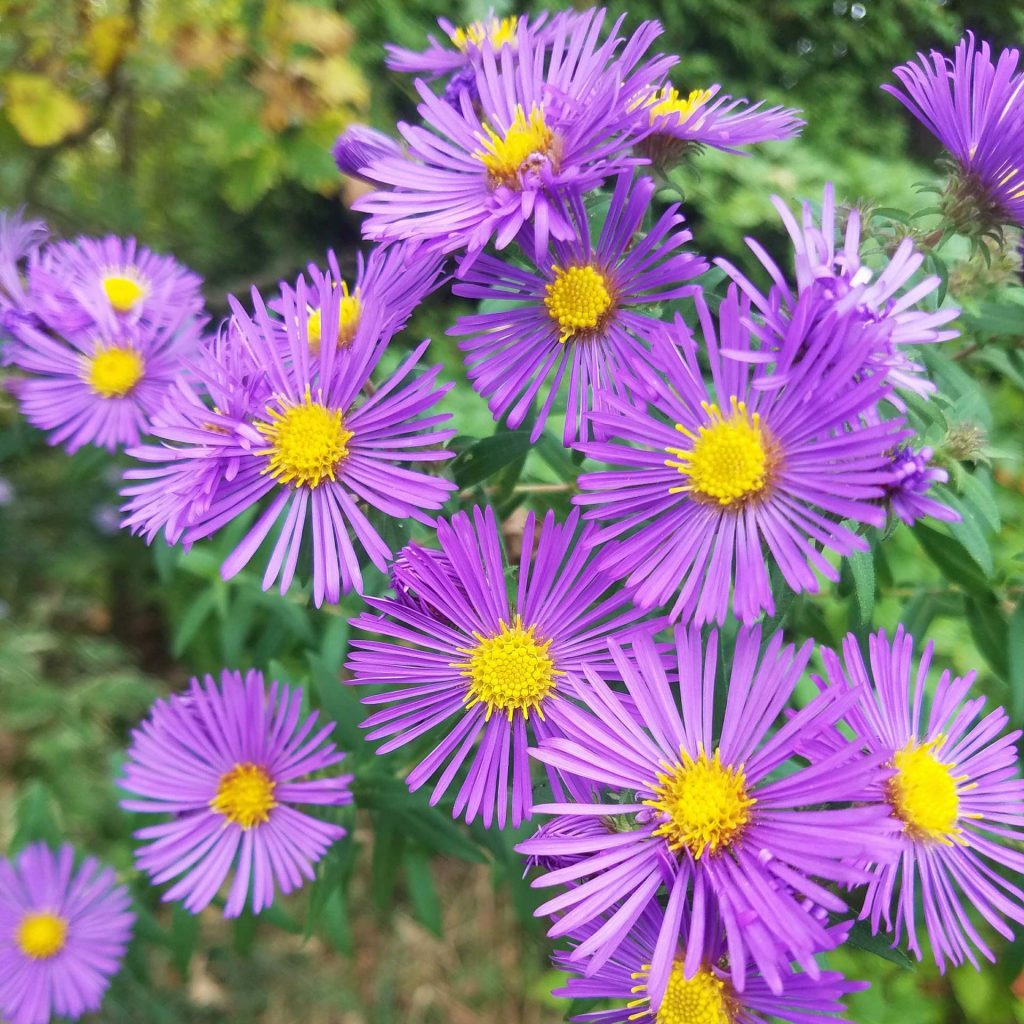The purple aster flower adds a stunning touch of color to any garden. It blooms when most other flowers fade, bringing energy and life to the late summer season. This flower’s charm lies in its star-shaped petals and deep symbolism of love, patience, and elegance.
Shawn McNulty’s abstract painting Aster captures this same vibrant spirit. The artwork features layers of bold yellow, violet, and dark blue, reflecting the dynamic energy of the aster in bloom. The mix of warm and cool tones feels alive—just like a field of purple asters glowing in the afternoon sun.

What Makes the Purple Aster Special
The purple aster stands out for its resilience and color. It belongs to the daisy family, known scientifically as Aster amellus. Its name comes from the Greek word for “star,” a fitting tribute to its petal shape.
This hardy perennial thrives in many climates. Gardeners love it because it’s easy to grow and attracts butterflies and bees. The blooms appear in late summer and continue into fall, providing vibrant color when most gardens start to fade.
Moreover, asters come in several shades—purple being the most iconic. This rich hue symbolizes royalty, wisdom, and peace. In ancient times, people believed burning asters could ward off evil spirits. Today, they simply bring beauty and positivity to homes and landscapes.
How to Grow Purple Asters
Growing purple asters is simple, but a little care goes a long way. Start by choosing a sunny spot with well-drained soil. Asters enjoy full sunlight, though they can handle partial shade.
Prepare the soil by mixing in compost or organic matter. This step improves drainage and gives the plant the nutrients it needs. When planting, space the asters about 1 to 3 feet apart. This allows good airflow and prevents mildew—a common issue with these flowers.
Water your asters regularly, especially during dry spells. They prefer consistent moisture but not soggy roots. Overwatering can lead to rot. It’s best to water early in the morning so the leaves can dry during the day.
Asters appreciate a light feeding in the spring. Use a balanced fertilizer or compost tea. Avoid high-nitrogen fertilizers since they encourage leaf growth rather than blooms.
Caring for Asters Throughout the Year
Regular care keeps asters healthy and full of color. Deadhead spent blooms to encourage new flowers. This simple act extends the blooming season well into fall.
Every few years, divide the plants in spring. Overcrowded asters can lose vigor and bloom less. Dividing them helps maintain strong growth and prevents disease.
Watch for powdery mildew. This white, dusty fungus often appears in humid conditions. To prevent it, give your plants space and water at the base, not on the leaves. If mildew appears, remove affected leaves and consider using a natural fungicide.
Cut asters back to about two inches after the first frost. This keeps the garden tidy and prepares the plants for winter. They’ll return stronger and fuller next spring.
Asters in Containers and Small Spaces
Don’t have a big garden? No problem. Purple asters grow beautifully in containers too. Choose a medium or large pot with drainage holes. Use quality potting soil, and make sure the container sits in a sunny spot.
Water container asters more often since pots dry out faster. Add mulch to retain moisture and protect roots. In winter, move the container to a sheltered area if you live in a cold climate. This helps the plant survive freezing temperatures.
Container-grown asters pair well with ornamental grasses, mums, or pansies. Together, they create a rich autumn display full of color and texture.
The Symbolism of the Purple Aster
The purple aster holds deep meaning across cultures. It often represents patience, love, and faith. In Victorian flower language, gifting asters showed deep emotional affection.
Because they bloom in fall, asters also symbolize endurance and hope. They remind us that beauty can thrive even as the seasons change. Their late bloom feels like nature’s encore—a final burst of color before winter arrives.
In mythology, the goddess Astraea created asters when her tears fell to Earth, forming star-like blossoms. That legend gives them a celestial quality. They connect heaven and earth, just as McNulty’s painting Aster seems to bridge the realms of nature and abstraction.
Common Varieties of Purple Asters
There are many types of asters to explore. Here are a few favorites:
- New England Aster (Symphyotrichum novae-angliae) – This variety features tall stems and rich purple blooms. It’s perfect for the back of garden beds.
- New York Aster (Symphyotrichum novi-belgii) – Compact and bushy, it suits borders and containers.
- Smooth Aster (Symphyotrichum laeve) – Its smooth leaves and lavender petals attract pollinators.
- Aster ‘Purple Dome’ – This dwarf variety offers dense clusters of purple flowers and resists mildew.
Each variety brings its own texture and shade. Mixing them creates a living painting of purples, blues, and pinks across your garden.
Fun Facts About Asters
Asters aren’t just pretty—they’re fascinating too. They’re the official birth flower for September and symbolize the end of summer.
The flowers attract monarch butterflies during migration. They also provide essential nectar for bees preparing for winter.
Interestingly, asters can survive mild frosts. Their toughness and color make them a symbol of resilience and beauty through change.
Native American tribes once used asters in herbal remedies. They believed the flowers had healing powers for coughs and headaches.
The Artistic Spirit of “Aster” by Shawn McNulty
Shawn McNulty’s painting Aster captures the same vitality found in a blooming field of purple asters. The piece explodes with color—lavender, orange, and deep indigo. The palette feels electric yet grounded.

Much like the flower, the painting balances chaos and harmony. The thick textures and layered strokes mirror nature’s unpredictable beauty. The violet tones represent calm and creativity, while the bursts of gold suggest sunlight breaking through.
McNulty’s abstract approach invites viewers to feel the energy rather than define it. You can sense the movement of petals in the breeze, or the shifting colors of a sunset over a flower field.
In this way, Aster becomes more than a painting—it’s an emotional landscape. It celebrates the same qualities that make the purple aster special: endurance, vibrancy, and joy in transformation.
Conclusion: A Bloom and a Brushstroke
The purple aster and Shawn McNulty’s Aster share a universal message. Both remind us that beauty thrives in contrast and transition. The flower blooms when most fade, and the painting radiates warmth against cool tones.
Growing asters brings life to your garden, while McNulty’s art brings that same energy to your walls. Together, they show that creativity—whether through petals or paint—can bloom in every season.
